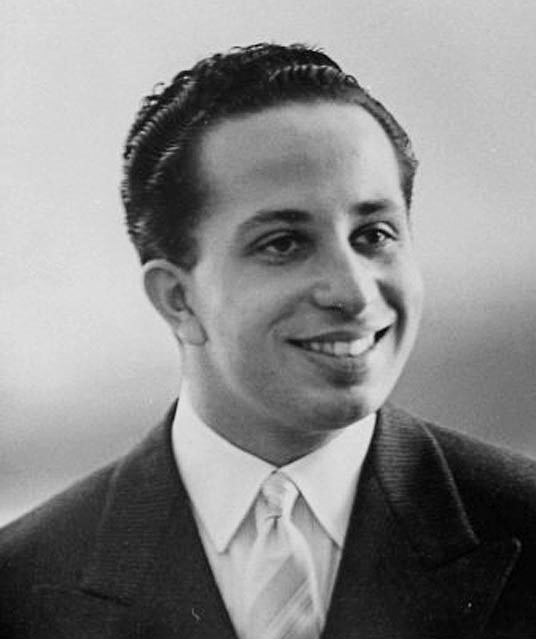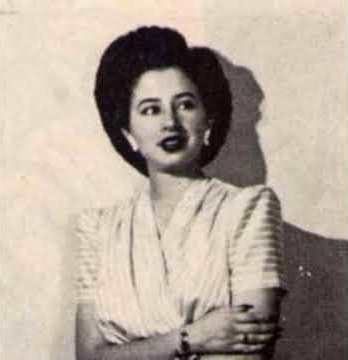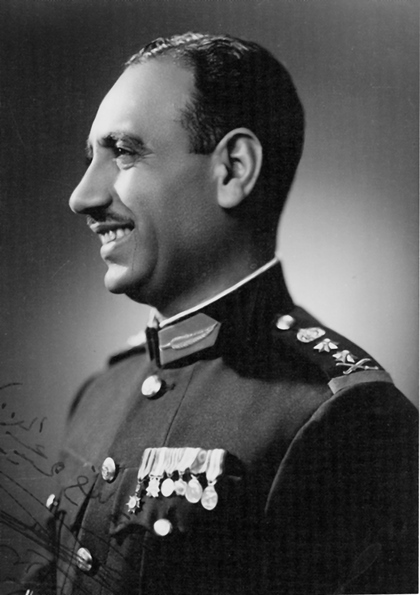by Susan Flantzer
© Unofficial Royalty 2023

Faisal II, King of Iraq; Credit – Wikipedia
On July 14, 1958, twenty-three-year-old Faisal II, the last King of Iraq, was assassinated at al-Rihab Palace in Baghdad, Iraq, along with members of the Iraqi royal family and palace staff during the 14 July Revolution, also known as the 1958 Iraqi military coup. This ended the thirty-seven-year-old Hashemite monarchy in Iraq.
The Hashemite Kingdom of Iraq
In 1921, Transjordan became an autonomous division of Palestine under the leadership of Sharif Abdullah bin al-Hussein, who then became Emir of Transjordan. Abdullah bin al-Hussein was the son of Hussein bin Ali, Sharif and Emir of Mecca, who was instrumental in starting the Great Arab Revolt against the Ottoman Empire. In 1916, Hussein bin Ali proclaimed himself King of Hejaz, a region of present-day Saudi Arabia, and also declared himself King of all Arabs. This last move enraged another Arab leader, Abdul Aziz Al Saud, who defeated Hussein bin Ali in 1924, causing him to abdicate the throne of Hejaz, and then became the first King of Saudi Arabia. Hussein bin Ali’s three sons all became kings: Ali bin Hussein was briefly King of Hejaz, Abdullah bin Hussein was King Abdullah I of Jordan, and Faisal bin Hussein was King Faisal I of Iraq and, for a very brief time, he was also King of Syria. King Faisal I was an important figure in the revolt against the Ottoman Empire and received assistance from British Army Captain T. E. Lawrence, better known as Lawrence of Arabia. King Faisal I of Iraq, aged forty-eight, died of a heart attack in 1933 and was succeeded on the throne by his eldest son, King Ghazi of Iraq.
Faisal II, King of Iraq

Five-year-old Faisal II, King of Iraq; Credit – Wikipedia
Faisal II, King of Iraq was born May 2, 1935, in Baghdad, Kingdom of Iraq, the only child of King Ghazi of Iraq and his first cousin Princess Aliya bint Ali of Hejaz, the daughter of Ali bin Hussein, who was briefly King of Hejaz, mentioned above. On April 4, 1939, twenty-seven-year-old King Ghazi of Iraq was killed in a suspicious car accident. Three-year-old Faisal succeeded his father as King Faisal II. Because Faisal II was underage, his maternal uncle, Prince Abdul Ilah, served as regent until 1953 when Faisal II came of age. Prince Abdul Ilah also served as Crown Prince of Iraq from 1943 until his death during the assassination. During World War II, Faisal II was evacuated along with his mother to the United Kingdom. He attended the Harrow School in Harrow on the Hill, Greater London, England, with his same-aged second cousin, the future Hussein I, King of Jordan.

Faisal II, King of Iraq (left) with his second cousin Hussein I, King of Jordan in February 1958; Credit – Wikipedia
Although Faisal II had three engagements, he never married. Faisal II first asked for the hand of Princess Shahnaz Pahlavi of Iran, the eldest daughter of Mohammad Reza Pahlavi, Shah of Iran, but the princess was unwilling. In 1957, Faisal II became engaged to Princess Kiymet Hanım, a descendant of the Mamluk dynasty of Iraq, but the engagement was broken three months later. At the time of his death, Faisal II was engaged to Princess Sabiha Fazile Hanımsultan, the only daughter of Prince Muhammad ‘Ali Ibrahim of Egypt, but Faisal II was killed two weeks before the scheduled wedding.
What caused the assassination of King Faisal II?

Abdul Salam Arif and Abd al-Karim Qasim, the leaders of the 14 July Revolution; Credit – Wikipedia
In 1958, neighboring Syria joined with Egypt to form the United Arab Republic, which Iraq did not recognize. This prompted the Hashemite kingdoms of Iraq and Jordan to strengthen their ties by establishing a similar alliance called the Hashemite Arab Federatio,n which was not universally accepted in Iraq. Tension between the United Arab Republic and the Hashemite Arab Federation worsened. During the summer of 1958, the movement of United Arab Republic troops to the Syrian border caused the Hashemite Arab Federation to mobilize troops to counter this move. Within Iraq, a group of Iraqi army officers called the Nationalist Officers Organization plotted against the monarchy. They were inspired by Gamal Abdel Nasser and the Free Officers Movement, who overthrew the Egyptian monarchy in 1952. In July 1958, Iraqi troops led by Colonel Abd al-Karim Qasim and Colonel Abdul Salam Arif were moving through Baghdad on their way to the Jordanian-Syrian border, and they took the opportunity, with troops having a legitimate excuse to be in Baghdad, to put their plan to overthrow the monarchy in motion. Colonel Abdul al-Salam Arif broadcast the statement of the revolution from the Baghdad Radio Building and helped plan and implement the coup with Colonel Abd al-Karim Qasim, who led the 19th Brigade of the Iraqi army.
The Assassination
Iraqi soldiers in front of the gutted Rihab Palace after the assassination
On July 14, 1958, King Faisal II was to travel to Turkey for diplomatic meetings and then travel to London to meet his fiancée, Princess Sabiha Fazile Hanımsultan. That morning, Faisal II was awakened at the al-Rihab Palace in Baghdad by the sound of gunfire. Members of the royal guard investigated, but they did not find the source of the gunfire. Then a servant heard on the radio the announcement of a revolution. From a nearby balcony, Faisal II’s maternal uncle, Prince Abdul Ilah, called to the royal guards outside the palace to investigate. The royal guards reported that many rebel soldiers had surrounded the palace.
The commander of the royal guard informed King Faisal II that rebel army units had taken control of important areas in Baghdad, had declared a republic, and were requesting the royal family to surrender. King Faisal II announced his surrender and was asked to leave al-Rihab Palace along with family members and the staff with him. Leaving the palace with the king were his maternal uncle Prince Abdul Ilah and his wife Princess Hiyam, his maternal aunt Princess Abadiya, his maternal grandmother Princess Nafissa, his Turkish cook Abigail Raziqia, and two members of the royal guard Lafi Al-Azmi and Captain Thabet.
Captain Abdul Sattar Sabaa Al-Ibousi, leading the rebel assault group at the al-Rihab Palace, ordered King Faisal II and those with him to gather in the palace courtyard. When they were passing the kitchen garden, through a row of rebel soldiers, the soldiers opened fire. King Faisal II was shot in the head and neck. Prince Abdul Ilah, Queen Nafisa, Princess Abadiya, and Captain Thabet of the royal guard were shot and died instantly. Princess Hiyam was shot in the thigh and was the only member of the royal family to survive. Abigail Raziqia, the Turkish cook, and Lafi Al-Azmi, a member of the royal guard, were injured but also survived.
The deceased and the survivors were then taken by car to the Ministry of Defense. King Faisal II reportedly died along the way, and the cars were stopped. King Faisal II’s body was hanged, and the body of Prince Abdul Ilah was defiled, dragged through the streets, and then burned. King Faisal II’s body was then transported to Al-Rashid Military Hospital to verify his death. In the evening, a hole was dug near the hospital, and King Faisal II’s body was buried. The remains of the others were transferred to Al-Rashid Military Hospital before they were burned and thrown into the Tigris River.

Tomb of King Faisal II of Iraq; Credit – Wikipedia
During the regime of Saddam Hussein (1979 – 2003), the remains of King Faisal II were reburied in a marble tomb next to his father’s tomb in the Royal Mausoleum in Baghdad, Iraq.

Princess Hayim, the only member of the royal family to survive; Credit – Wikipedia
Princess Hiyam, the wife of Prince Abdul Ilah, was the only member of the royal family to survive. In the confusion after the initial shooting, she was protected by some soldiers from her family tribe. Princess Hiyam later married her cousin and had two children. In the 1980s, she managed to escape from Iraq and lived the rest of her life in Jordan, where she died in 1999, aged 66.
What happened to the conspirators?
Abd al-Karim Qasim assumed the posts of Prime Minister and Defense Minister, and Abdul Salam Arif became Deputy Prime Minister and Interior Minister. They were the highest authority in Iraq with both executive and legislative powers.

Abd al-Karim Qasim; Credit – Wikipedia
In 1962, both the Ba’ath Party and the United States Central Intelligence Agency began plotting to overthrow Abd al-Karim Qasim, with United States government officials cultivating supportive relationships with Ba’athist leaders and others opposed to Qasim. On February 8, 1963, Qasim was overthrown by the Ba’athists, long suspected to be supported by the CIA, in the Ramadan Revolution. After a short show trial on February 9, 1963, Abd al-Karim Qasim was shot by the Ba’athists at the Iraqi Ministry of Defense building.

Abdul Salam Arif; Credit – Wikipedia
Almost immediately after taking power in 1958 with Abd al-Karim Qasim, Abdul Salam Arif had issues with him. The two leaders engaged in a power struggle, ending with Qasim prevailing and the removal of Arif from his positions on September 12, 1963. Before the coup that overthrew Qasim, Arif had been selected as the leader of the Iraqi Revolutionary Command Council, and after the coup, he was elected President of Iraq. He served as President of Iraq until he died in an airplane crash on April 13, 1966.

Abdul Sattar Sabaa Al-Ibousi; Credit – Wikipedia
In 1970, Abdul Sattar Sabaa Al-Ibousi, then a colonel in the Iraqi army, who had been the leader of the revolutionary assault group at Rihab Palace, died by suicide, after suffering from remorse and guilt for twelve years.
The Aftermath
The Ramadan Revolution, from February 8 -10, 1963, established the Ba’athist government in Iraq. In 1957, a 20-year-old Iraqi joined the Ba’ath Party. He became a leading member of the revolutionary Arab Socialist Ba’ath Party, and later, the Baghdad-based Ba’ath Party. He played a key role in the 17 July Revolution of 1968 that ousted the moderate faction of the Ba’ath Party and was appointed Vice President of Iraq in 1968. On July 16, 1979, he acted to secure his grip on power and forced the ailing President Ahmed Hassan al-Bakr of Iraq to resign, and then he assumed the presidency. His rule was marked by numerous human rights abuses, including an estimated 250,000 deaths and disappearances. He remained President of Iraq until 200,3 when the United States led an invasion of Iraq. The Ba’ath Party was banned, and he went into hiding and was captured on December 13, 2003, hiding in a hole. On November 5, 2006, he was convicted (Wikipedia: Trial of Sadam Hussein) by the Supreme Iraqi Criminal Tribunal of crimes against humanity related to the 1982 killing of 148 Iraqi Shi’a and sentenced to death by hanging. Saddam Hussein was executed on December 30, 2006.
Iraq continues to be a politically unstable country with civil unrest and a dysfunctional government.
This article is the intellectual property of Unofficial Royalty and is NOT TO BE COPIED, EDITED, OR POSTED IN ANY FORM ON ANOTHER WEBSITE under any circumstances. It is permissible to use a link that directs to Unofficial Royalty.
Works Cited
- Lessware, S. A.-S. and J. (2018, July 15). 60 years on, Iraqis reflect on the coup that killed king Faisal II. Arab News. https://www.arabnews.com/node/1339046/middle-east
- Teller Report. (2021). The attempt of the leaders of the 1958 coup to simulate the Egyptian experience of banishing the king did not see the light… The mysteries and secrets of the killing of the royal family in Iraq. https://www.tellerreport.com/news/2021-07-15-the-attempt-of-the-leaders-of-the-1958-coup-to-simulate-the-egyptian-experience-of-banishing-the-king-did-not-see-the-light—-the-mysteries-and-secrets-of-the-killing-of-the-royal-family-in-iraq.B1BMdq2a6O.html
- Wikimedia Foundation. (2023). 14 July Revolution. Wikipedia. https://en.wikipedia.org/wiki/14_July_Revolution
- Wikimedia Foundation. (2023). Abd Al-Ilah. Wikipedia. https://en.wikipedia.org/wiki/Abd_al-Ilah
- Wikimedia Foundation. (2023). Abd al-Karim Qasim.Wikipedia.https://en.wikipedia.org/wiki/Abd_al-Karim_Qasim
- Wikimedia Foundation. (2023). Abdul Salam Arif. Wikipedia.https://en.wikipedia.org/wiki/Abdul_Salam_Arif
- Wikimedia Foundation. (2023). عبد الستار العبوسي Abdul Sattar Al-Abousi. Wikipedia (Arabic). https://ar.wikipedia.org/wiki/%D8%B9%D8%A8%D8%AF_%D8%A7%D9%84%D8%B3%D8%AA%D8%A7%D8%B1_%D8%A7%D9%84%D8%B9%D8%A8%D9%88%D8%B3%D9%8A
- Wikimedia Foundation. (2023). قصر الرحاب al-Rahib Palace. Wikipedia (Arabic). https://ar.wikipedia.org/wiki/%D9%82%D8%B5%D8%B1_%D8%A7%D9%84%D8%B1%D8%AD%D8%A7%D8%A8
- Wikimedia Foundation. (2023). فيصل الثاني (Faisal II, King of Iraq). Wikipedia (Arabic). https://ar.wikipedia.org/wiki/%D9%81%D9%8A%D8%B5%D9%84_%D8%A7%D9%84%D8%AB%D8%A7%D9%86%D9%8A
- Wikimedia Foundation. (2023). Faisal II of Iraq. Wikipedia.https://en.wikipedia.org/wiki/Faisal_II_of_Iraq
- Wikimedia Foundation. (2023). Saddam Hussein. Wikipedia. https://en.wikipedia.org/wiki/Saddam_Hussein
